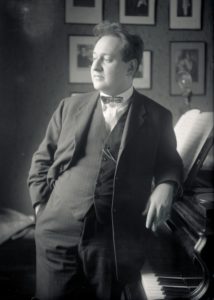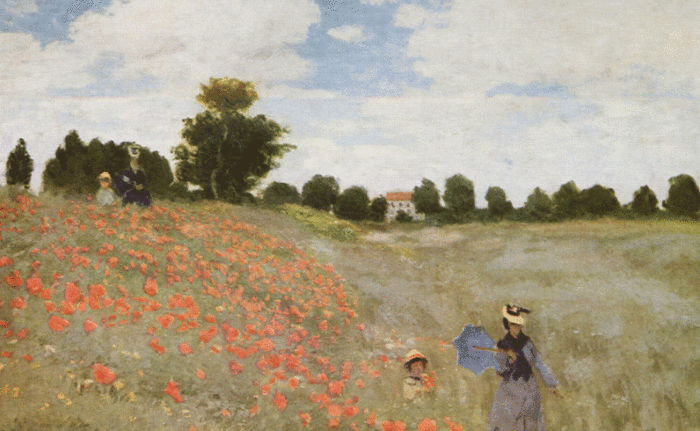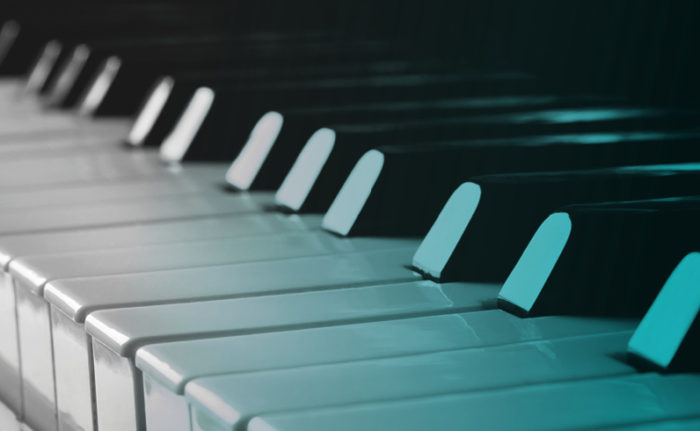On January 24, 26 and 27, internationally renowned violinist Baiba Skride returns to Houston to play Korngold’s virtuoso Violin Concerto. In this post, discover how the master film composer of Hollywood’s golden age transformed his movie themes into one of the best-loved concertos of the 20th century. Get tickets and more information here.
Whenever Korngold invited the violinist Bronisław Huberman to dinner, the virtuoso invariably asked his host, “So, Erich, where’s my violin concerto?” For about thirty years he received no response, but on one occasion in 1945, the composer sat down at the piano and played a soaring, lyrical theme. “That’s it!” Huberman exclaimed, “That will be my concerto—promise me that you’ll write it.”
In fact, Korngold had written the melody several years earlier and incorporated it into the score of the 1937 Warner Brothers film Another Dawn. At the same time as his work on the film, Korngold began to sketch a violin concerto based on the theme (whether the film score or the concerto sketches came first is difficult to know), but after an unsuccessful run through with a violinist who was not equal to its technical challenges, Korngold abandoned it. Perhaps he believed that he had written an unidiomatic solo part, but there may also have been deeper reasons for his laying aside what would become his most popular work.
Escape to Hollywood

Korngold had begun as a Mozart-like child prodigy in Vienna, hailed as a genius by great composers like Gustav Mahler and Richard Strauss. In the 1930s, however, he had begun composing film scores for Hollywood, a side gig that would turn out to save his life. The rise of the Nazis in neighboring Germany posed a grave threat to the Jewish composer and his family, and it was only thanks to an offer to score the classic 1938 swashbuckler The Adventures of Robin Hood that they escaped Austria before the Anschluss.
During the war, Korngold stopped composing operas and concert works altogether. “It was as if he had taken a vow not to compose a single note outside the genre of film music for as long as the horror was raging throughout the world,” his wife Luzi later recalled. Perhaps Hollywood’s fantastic adventure stories and romances offered Korngold an escape from the realities of living in exile as the Vienna he had always known was destroyed. Whatever his motivations were, Korngold revolutionized film music, and helped to define the lush, operatic sound we associate with the golden age of Hollywood.
His father, the prominent music critic Julius Korngold, always saw his cinematic work as a waste of time, and continually implored him to return to writing more “serious” pieces. Korngold never agreed with his father’s assessment, but nevertheless, he did return to writing concert music just before Julius died in 1945. One of his first projects was the completion of the discarded sketches of his violin concerto.
Even his father had to admit that Korngold’s film scores contained some very fine music, and he would often suggest that his son recycle his best ideas in future compositions. Though Korngold took film music seriously, he always worried that his scores might be forgotten along with the movies they appeared in. Indeed, though some of the films he scored have become classics, many are remembered today by only the most avid movie buffs. All of the main themes from the concerto are derived from film scores, and this concert incarnation has given them a life beyond the silver screen. The concerto is far from being a medley of movie themes, however; Korngold substantially reworked and developed his melodies into a truly symphonic structure.
A “Hollywood Concerto”
Sadly, Huberman, the violinist who had waited decades for Korngold to write his concerto, would never perform the work in public, as he was unable to fit it into his already busy concert schedule before his death in 1947. Instead the premiere went to the legendary Jascha Heifetz, who actually encouraged Korngold to increase the technical difficulties of the solo part. The premiere took place in St. Louis on February 14, 1947. “The reception of the Violin Concerto in St. Louis was triumphal,” Korngold wrote. “A success just as in my best times in Vienna.” One reviewer even predicted that the concerto would remain in the repertoire for as long as Mendelssohn’s. “I do not need more than that!!” Korngold exclaimed.
Unfortunately, the critics in New York were not as kind. Despite the audience’s enthusiastic response at the concerto’s New York premiere, Olin Downes panned it as a “Hollywood Concerto” in the New York Times, reflecting a general prejudice against both film music and Korngold’s lush, post-romantic musical style prevalent in critical circles of the time. Undaunted, Heifetz maintained the concerto in his repertoire, but for decades few other violinists took it up. Beginning in the 1980s, however, the concerto began to experience a renaissance, and it is now regularly performed throughout the world. On this occasion, it seems the St. Louis critic proved more perceptive than his New York counterpart.
Music from the Movies
The soloist opens the concerto with the theme from Another Dawn, a romantic melodrama set in a vaguely North African British colony:
Starring Errol Flynn and Kay Francis, the film centers on a love quadrilateral in which the characters are all too noble to act on their true feelings. Despite miscasting, a romanticized portrayal of British imperialism and a rather purple script, the main melody (associated with both love and flight—Errol Flynn’s character is a pilot) proved one of Korngold’s best:
A spritely transition full of virtuoso passagework for the soloist leads to the second main theme of the first movement. Though it is just as lyrical as the first, this theme’s more restricted range gives it an introspective, perhaps even melancholy character. This melody was adapted from the 1939 film Juarez, a historical epic about the ill-fated attempt of the French to establish an empire in Mexico during the 1860s:
Korngold’s wife later reported that during his time in Hollywood, a film’s story became for her husband “an opera libretto—at least this is how he adapted it—and he was able to convince himself of the perhaps deliberate delusion that he was creating an operatic work.” This conception of film as opera is particularly apparent in Juarez. It is easy to imagine its main characters as opera singers: Maximilian a lyric tenor, Juarez a noble baritone, Napoleon III a Mephistophelian bass, and Carlotta (Maximilian’s wife) the long-suffering soprano. The theme used in the concerto is most associated with Carlotta, who was played by Bette Davis, an actress whose voice and movements Korngold often found inspiring. The theme first appears when Maximilian prepares to break the news to her that she cannot have children and that he plans to adopt in order to secure the succession. You can hear the theme at the beginning and end of this clip, which ends just before he tells her:
It later recurs during her operatic mad scene. This clip immediately precedes the recurrence of the theme:
https://www.youtube.com/watch?v=ByszLQ_UUd4
The two themes are developed and reprised in a movement notable for its exquisite lyricism. Regarding the lyrical nature of the concerto, Korngold remarked that “the work with its many melodic and lyric episodes was contemplated rather for a Caruso of the violin than for a Paganini. It is needless to say how delighted I am to have my concerto performed by Caruso and Paganini in one person: Jascha Heifetz.”
The slow second movement takes its main theme from Korngold’s Oscar-winning score to Anthony Adverse (1936), an adaptation of a 1,168 page bestselling historical novel (!) about a an aristocratic love-child’s quest to find his way in the world at the turn of the nineteenth century (when Jack Warner was told to read the book he responded “Read it? I can’t even lift it!”). Despite some good scenes, the film suffers from a rather loose, episodic structure as well as a number of plot points that will likely seem deeply problematic to modern audiences:
https://www.youtube.com/watch?v=Ss7ONnzv–U
In the film the theme occurs in full twice: once when Anthony (the protagonist, played by Frederic March) and his childhood sweetheart Angela (played by Olivia de Haviland) are riding in a carriage discussing their hopes for a future together, and again when they are reunited years later. Like the themes of the first movement, it is a love theme, although the hopes it expresses are ultimately frustrated in the film as fate conspires to keep the lovers apart.
After a brief, atmospheric introduction, the soloist begins the Anthony Adverse theme, which unfolds in three parts: an understated, lyrical beginning; a more passionate, sequential transition; and a relaxed ending. A contrasting middle section features more fragmentary, chromatic motifs and mysterious harmonies that lead back to a return of the Anthony Adverse melody. The movement ends with a brief reminiscence of the mysterious middle section.
The last movement is based on the main theme from The Prince and the Pauper, a 1937 adaptation of Mark Twain’s fable starring the twins Billy and Bobby Mauch (Errol Flynn also makes an appearance as a helpful mercenary, and Claude Rains plays a murderous, scheming courtier):
Of the films Korngold mined for music for this concerto, this one remains the most watchable today. In the film, the theme is mainly associated with the two titular characters and the hand of fate that brings them together. Like the finales of Dvořák’s Eighth Symphony and Bartók’s Second Violin Concerto, this movement is a theme and variations disguised as a sonata form with a contrasting second theme, a brief development and a reprise. In fact all of these episodes are cleverly disguised variations of the main theme. Korngold presents an astonishing array of creative variants on this playful tune, leading to a thrilling—perhaps even Hollywood-worthy—happy ending.
Don’t miss Korngold’s Violin Concerto on January 24, 26 and 27! Get tickets and more information here.



